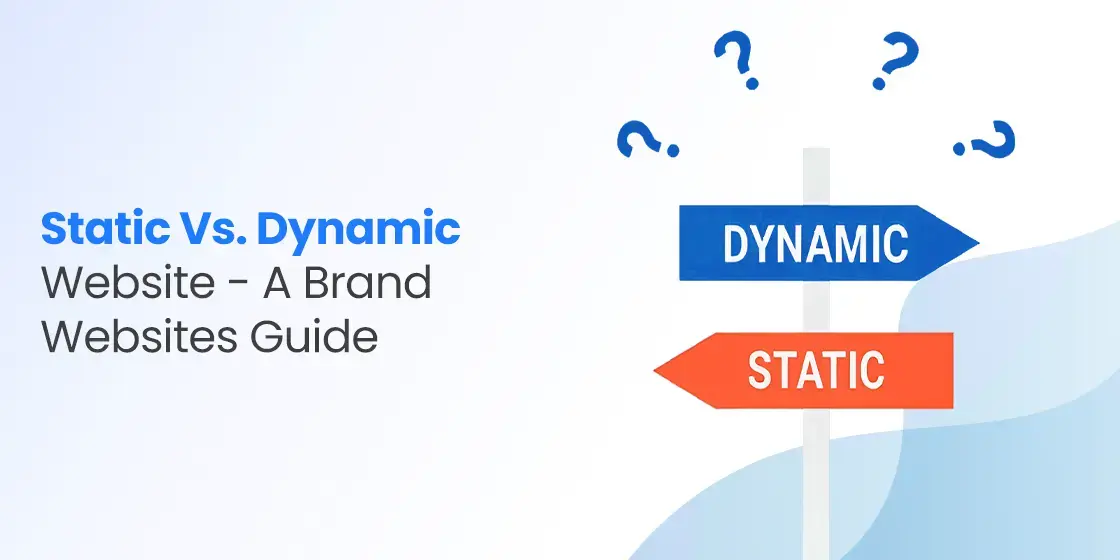Table of Content
Learn the Key Areas That Makes Static Sites Different From Dynamic Sites
When it comes to creating a website, many stakeholders often find themselves uncertain about whether to opt for a static or dynamic approach. This confusion typically arises due to a lack of clarity on how each type of website functions and serves content to users. Making the right decision requires understanding not just the technical differences between static and dynamic websites, but also how those differences impact the overall user experience, maintenance, and long-term scalability of the site.
At its core, the distinction between static and dynamic websites lies in how they deliver and display content to users. Static websites consist of fixed content, where each page is individually coded and remains the same for every visitor. These types of websites are generally faster to load and easier to develop initially. In contrast, dynamic websites generate content in real-time based on user interactions. This allows for a more personalized and interactive experience, but it also adds layers of complexity in terms of development and maintenance.
Choosing between a static or dynamic website should be based on the specific needs and goals of the project. If you are a beginner developer with no knowledge about static and dynamic websites, read this article in detail. It will let you know key differences between both sites, so that you can offer web development services for each of them with precise knowledge and resources.
What is a Static Website?

A static website is a type of website that delivers pre-written, fixed content to users. Each page is a separate HTML file that looks the same for every visitor, regardless of who they are or how they interact with the site. These pages are created manually or with the help of static site generators and are typically hosted on a web server. Because the content is hard-coded into each page, there is no server-side generation of content or real-time data fetching involved during user visits.
One of the main advantages of static websites is their speed and simplicity. Since the content does not change dynamically, the browser can load each page quickly. Additionally, static websites are easier to secure because they don’t rely on server-side scripting or databases, which are common targets for attacks. This makes them a reliable choice for small websites where the information doesn’t need frequent updates or interactive features.
However, static websites also have limitations when it comes to flexibility and scalability. Updating content on a static website often requires manual changes to the HTML files, which can become time-consuming as the site grows. They also lack built-in functionality for handling user input, storing data, or generating personalized content. While tools like JavaScript and static site generators can add some interactivity and automation, a static website is generally best suited for projects where content remains consistent and doesn’t require frequent or real-time updates.
Elevate your online presence with websites that blend visual appeal with advanced functionalities. Explore our tailored web development solutions today.
Discover Web SolutionsAdvantages of a Static Website
A static website offers tons of advantages to the users. If you do not know how beneficial these sites are, take a look at its advantages given below.
Faster Speed
A static page is designed with an emphasis on fast website loading, which contributes significantly to an improved browsing experience for users. Since the content on a static website is pre-written and stored as individual HTML files, it can be delivered quickly and directly from the server without requiring any real-time processing.
Another key advantage of this setup is the ease of caching, which further enhances performance and reliability. Because the content does not change dynamically, browsers and servers can efficiently cache entire pages, allowing repeat visits to load even faster.
Top Security
Static website pages tend to offer a higher level of security compared to dynamic websites, primarily because they have a simpler structure and fewer components that can be exploited. These websites consist of fixed files such as HTML, CSS, and sometimes JavaScript, which are served directly to the user without the need for server-side processing or database interactions.
Since static sites do not rely on server-side scripting languages or backend databases, there are fewer entry points for malicious activity. Common threats such as SQL injections, cross-site scripting (XSS), and server-side code exploits are largely irrelevant in the context of a purely static site.
Fast Development
Static websites are generally quicker to build and launch due to their straightforward architecture and lack of dependence on complex backend systems. Since these websites consist of individual HTML pages with fixed content, developers can focus on designing and coding each page directly without having to set up databases, server-side scripting, or dynamic content management features.
Additionally, because static websites don’t require integration with content databases or external data sources, they can be deployed with minimal configuration. There is no need for installing or maintaining content management systems, establishing data connections, or writing backend logic to retrieve and display content.
What are Dynamic Websites?

Dynamic websites are websites that generate content in real-time based on user interactions, preferences, or data pulled from a server or database. Unlike static websites, which deliver the same content to every user, dynamic sites personalize and update their pages depending on specific inputs or conditions. This type of site typically relies on server-side technologies such as PHP, Python, or Node.js, in combination with databases like MySQL or MongoDB, to build pages on demand.
One of the defining features of a dynamic website is its ability to handle complex functionalities and present constantly changing information. Websites that require frequent updates, user interaction, or content management systems (CMS) often fall under the dynamic category. Examples include e-commerce platforms, social media networks, blogs with commenting features, and news websites.
While dynamic websites offer greater flexibility and functionality, they also come with increased complexity. Developing and maintaining them requires more advanced technical knowledge, as developers must handle both front-end and back-end development, database design, security measures, and performance optimization. Additionally, because content is generated on-the-fly, dynamic websites can be slower to load than static ones if not properly optimized.
Advantages of Dynamic Websites
Just like static websites, there are plenty of advantages of dynamic sites that help administrators to get engagement from the visitors. If you do not know much about them, take a look at the benefits defined below.
Easy to Update
One of the key advantages of a dynamic website is its ability to manage and update content efficiently across multiple pages. When a change is made to a specific piece of content—such as a company description, product detail, or promotional message—it can automatically reflect on all pages where that content appears.
This centralized approach eliminates the need to manually edit individual pages whenever an update is required, which not only saves time but also reduces the likelihood of errors or inconsistencies across the site.
Interactive Experience
A dynamic website has the capability to deliver content that is customized to functional requirements, preferences, or behavior. Rather than displaying the same static information to everyone, the site can adapt in real-time based on data collected from the user.
One common example of this personalization is location-based content delivery. This tailored approach not only enhances user satisfaction but also increases the likelihood of engagement, conversions, or return visits.
Stunning Functionality
Dynamic pages are designed to offer a much broader range of functionality that adapts and responds in real time. These pages can handle complex tasks such as processing user inputs, updating data without requiring a full page reload, and integrating with other systems or services.
This kind of functionality is essential for modern web applications and services that aim to deliver a rich, interactive, and user-focused experience.
Frequently Asked Questions
| What is a static website? A static website is made up of fixed HTML pages where the content remains the same for every visitor. It delivers pre-written files directly from the server without real-time processing or database interaction. |
| What is a dynamic website? A dynamic website generates content in real-time based on user input, preferences, or data from a database. It delivers personalized and interactive experiences using server-side processing. |
| What are the differences between a static and dynamic website? A static website shows the same fixed content to all users, while a dynamic website generates customized content based on user interactions or data. Static sites are simpler and faster, whereas dynamic sites offer greater functionality and personalization. |
Final Words
That concludes our entire article in which we have discussed core differences between a static and dynamic website. Understanding these differences is important for developers, as it allows them to pick the right site required for each project. It is therefore a good read for the beginners who are just starting their careers, looking to know how static vs dynamic websites differ from each other.
Empower your digital initiatives with BariTechSol, a premier custom software development company. Our skilled team tailors cutting-edge solutions to your unique needs. Elevate your tech experience and stay ahead in the digital realm. Partner with BaritechSol and code the success of your next big idea.


